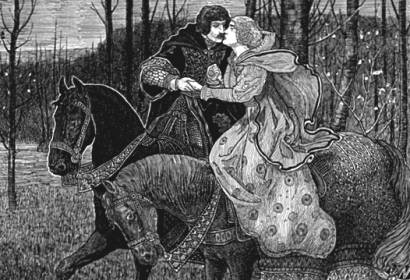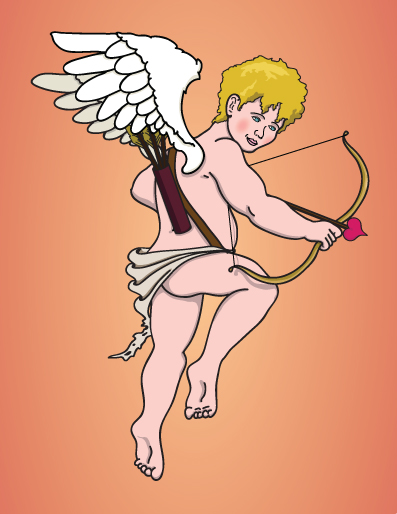St. Valentine's Day: A Brief History

Well by Noam DePlume

That frog has all the answers.
But you have to wonder--just where did this holiday come from, anyway? Most people are vaguely aware of Saint Valentine as a figure from the Catholic canon--but he's not exactly a saint that you hear much (if anything) about the other 364 days a year. And what's all this about Hallmark inventing it as some sort of sinister money-making scheme, is that even possible? This year, I decided to get to the bottom of it.
Valentinus - The Man Himself

Artist's rendition of what St. Valentine maybe could have possibly looked like.
Very little is known about the life of Valentinus of Rome--actually, all that can be said authoritatively on the matter is that he was a Christian who lived during the third century A.D., and that he was executed on the Via Flaminia, a road north of Rome. February 14th is traditionally given to be the date of his death, but really, it was seventeen-hundred years ago, so who can say for sure? I'm pretty hazy on the date of my college graduation, and it hasn't even been a decade.The exact cause of his martyrdom is far from clear, but the various stories seem to agree that he was beaten, stoned and beheaded outside the Flaminian Gate under the orders of Emperor Claudius II for refusing to deny the divinity of Jesus. The Nuremburg Chronicle claims that Valentinus was first arrested for performing marriages between Christians--hence the possible tie-in with the concept of romance--but this account wasn't published until 1493, so one has to wonder about its veracity (although who knows, maybe an angel visited Hartmann Schedel in a dream to help fill in a few gaps in the biography of an obscure saint from over a thousand years earlier. Anything's possible when miracles are in the mix.)
.jpg)
One of the "Monstrous Races" from the Nuremburg Chronicle.Clearly, Schedel had an excellent fact-checker.
In one version of the story, Valentinus passes a note reading "From Your Valentine" through the bars of his cell to the jailer's daughter (whom I guess he cured of blindness), as a farewell, thereby laying the groundwork for the tradition of exchanging cards on Valentine's Day. Oddly enough, this story is attributed to a different St. Valentinus (of Terni), who was also executed along the Via Flaminia, just in a different spot, and at the orders of a different emperor (Aurelian). Because of the bizarre similarities in these stories, liturgical historians often speculate that both stories refer to the same person. Anyway, notwithstanding all of the obscurity surrounding his life and accomplishments and the basic question of was this even one guy, his supposed skull, wreathed in flowers, is on display as a holy relic in the Basilica of Santa Maria in Cosmedin, Rome. How... uh, romantic.

Nothing says "I Love You" like a decapitated head.
The Feast of St. Valentine
The Feast of St. Valentine was first established by Pope Gelasius I in 496. Gelasius said of St Valentine: "[he is among those] whose names are justly reverenced among men, but whose acts are known only to God." Translation: This man is a saint, and he deserves to be honored as such, even though nobody is actually sure why. One theory among historians is that Gelasius, an avid suppressor of Pagan rites and rituals, originally promoted the feast as a Christian alternative to the ancient festival of Lupercalia which, wouldn't you know, took place on Feb. 13th to 15th. Whatever the impetus, the Feast of St. Valentine remained on Catholic calendars before becoming anything close to the holiday that we now know and love (or hate).
 Lupercalia (left) vs. Valentine's Day (right). I think we lost out on this deal.
Lupercalia (left) vs. Valentine's Day (right). I think we lost out on this deal.
The Love Connection
If it seems strange that St. Valentine's Day existed for like a millenium before ever getting tied to the concept of romantic love, it will probably sound like downright nonsense when I tell you that even the very idea of romance as we understand it today is a fairly modern invention. Easy, tiger--let me explain: for most of European history, marriages were a pretty formal business affair. Particularly among the upper classes, women were basically bought and sold by the men in their lives, daughters wedded to sons to merge bloodlines, and thus cement relationships between two powerful fathers. Husbands and wives were expected to care for one another, but the idea of being in love as an irrational, all-consuming obsession pretty much didn't enter into the picture. Around the 14th or 15th century, the concept of courtly or chivalrous love began to emerge in writing. Again, this love wasn't supposed to exist between husband and wife, but rather between two individuals whose intense passion for one another could never be consummated due to their social obligations--say, a knight and a lady.

Lancelot and Guinevere: the Brangelina of the Middle Ages.
Actually, one of the most famous examples of courtly love is that between Guinevere, King Arthur's wife, and Lancelot, one of his Knights of the Round Table. Lancelot courts Guinevere, proclaiming his undying affection and unflinchingly risking life and limb for small tokens of her esteem. If you ever read the King Arthur stories and wondered why Lancelot never got his testes removed with a broadsword, well, now you know why. The concept of romantic love as an intense emotional or spiritual connection wasn't considered especially scandalous as long as it never manifested physically beyond a longing glance or a dignified peck on the cheek. The modern romantic ideal of doing anything for one's true love and expecting nothing in return, was borne out of the concept of courtly love. This idea was only explicitly connected with St. Valentine's day in 1382 in Geoffrey Chaucer's poem "Parlement of Foules", in which all the birds of the earth gather on Valentine's day to choose their mates. How exactly this got the ball rolling is really anyone's guess.

Geoffrey Chaucer is for lovers.
Love in the Modern Era

Mass-produced Valentine from the mid-19th century. Note the tacky awfulness.
By the early 19th century, the practice of lovers exchanging notes and other tokens of their affection had taken hold. So of course, thanks no doubt to the dispassionate efficiency of Industrial Revolution-era thought, stationery retailers started to carry mass-produced paper Valentines printed with sickly-sweet little cherubs and snatches of canned sentimentality. Finally, with the process of expressing one's deepest feelings reduced to the act of simply shelling out a few coins for someone else's one-size-fits-all concept of love and tossing it in the Royal Mail on your way to the druggist, do we begin to recognize Valentine's Day in its modern form. From the Victorian era until today, the only thing that's really changed about the holiday are the specifics of what you're expected to cough up a little change for--from cards to flowers to chocolates to those awful little stuffed animals that must just get thrown in the trash or else stuffed into the back of a closet somewhere.

Cupid, now traditionally associated with the concept of romantic love, was originally Eros, the Greek god of sexual attraction.
So where does all of this leave us? Well, in barest terms, St. Valentine's day celebrates the unknown accomplishments of a nearly two-millenia-old man who may actually have been two different men, plus the noble sexual frustration of knights who couldn't get laid without seriously screwing up society, through the exchange of millions of near-identical snippets of plagarized sentiment. At least, that's one way to look at it.
But why be so cynical? Valentine's day is ultimately what you make of it. Like many holidays, it's really just a good excuse to celebrate life and the people you love. If you can look past the schmaltzy ads and the consumerist fervor, you're left with a day dedicated to the people who mean the most to you. And sure, maybe the modern concept of love is a relative newcomer in the history of human civilization, but that doesn't mean that it's fake. So my advice: walk the middle path. Don't get stuck on the idea that love is measured in bon bons and teddy bears, but don't sit home and wallow in your bitterness, either.

Article by Private Island Party 2013. privateislandparty.com






0 Comments